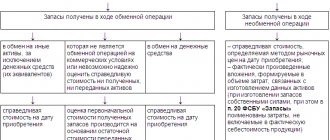Financial plan of a government institution
The estimated annual estimate of income and expenses (budgetary institutions do not prepare it) of a government institution is a financing plan for a certain period.
Government organizations use standardized forms in form 0501012 to distribute their own expenses and adjusted limits. The unified form is valid only for federal public sector employees. Which document regulates the rules for drawing up budget estimates - Order of the Ministry of Finance No. 26n dated February 14, 2018. This legal act contains key recommendations for filling out the form, one of which is posting the estimate in the Electronic Budget system.
ConsultantPlus experts sorted out mistakes when filling out budget estimates. Use these instructions for free.
To read, you will need access to the system: .
In relation to regional and municipal organizations, the form and rules for filling out are established by the GRBS (main distributors of budget funds).
IMPORTANT!
Do not confuse the concepts of budget estimate and financial budget plan. Every year, a PFHD is drawn up to finance a budgetary institution, but estimate documents are provided for government-type organizations and for local governments. The feds post both documents in the Electronic Budget.
When preparing an estimate document, it is imperative to fill out justification (calculation) forms for planned estimate indicators. New forms have been in effect since 2022 - the Ministry of Finance approved Order No. 87n dated June 17, 2021 and introduced 197 new calculations. Order of the Ministry of Finance 139n dated 06/20/2018 is no longer valid as of 01/01/2022.
Use free instructions from ConsultantPlus experts to correctly fill out the updated forms.
To read, you will need access to the system: .
Types of estimates
An estimate is an almost obligatory part of preparation for any project that involves financial expenses. This is not one document, but a complex of papers. These include this documentation:
- Summary calculation.
- Spending summary.
The composition of the documentation that usually accompanies the implementation of the project:
- Local estimates . Included in the primary documentation. Filled out for individual areas of work.
- Local calculations . They are relevant when the scale of work and costs have not yet been established or all values can only be clarified during construction.
All these documents are completed on the basis of official documentation. Along with them, other papers can be compiled: a statement of the estimated cost of various objects.
Structure and filling rules
Remember: the activities of a government-type institution are financed based on the budget estimate. The main managers of budget funds generate notifications about the completed amounts of funding, after which recipients draw up estimates for 2022. Take into account the established liability limits in accordance with the intended purposes.
Order No. 26n stipulates how many sections the current form of budget estimates has - 6 sections:
- in section No. 1 we indicate only the final estimates, that is, summary data for all sections;
- section No. 2 - we decipher the LBO on expenses for performing the functions of government institutions, disclose information about the main types of expenses of a government institution, including wages, other payments to personnel, purchases of goods (works, services), payment of taxes and other obligatory payments, compensation for damage and etc.;
- Section No. 3 - LBO on the costs of providing certain types of government financing, including information on the following areas: investments, subsidies, interbudgetary transfers, payments, contributions and transfers to subjects of international law, servicing public debt, execution of judicial acts, state guarantees and reserves expenses;
- section No. 4 - we disclose information about personal financial support on expenses of the recipient of funds for the purchase of goods (works, services) in favor of third parties;
- section No. 5 - we indicate information on the volume and directions of expenses for the fulfillment of accepted public regulatory obligations, we indicate background information;
- section No. 6 - foreign currency exchange rate to the ruble, only reference information is indicated; all transactions made in foreign currency are converted into rubles at the appropriate rate.
If the founder has established additional detail for the institution, then fill out the column for the code of the analytical indicator in the structure of the budget of the government institution according to the established requirements. When allocating expenses, take into account the instructions of the Ministry of Finance from Order No. 85n dated 06/06/2019 regarding the definition of BCC, codes of types of expenses and KOSGU. At the request of higher-level managers, it is permissible to include additional details in the document according to KOSGU (Order No. 209n). The generated estimate is placed in the “Electronic Budget” together with justifications for each expense item.
Types of expenses
Funds are spent on such needs:
- wages of employees working for hire;
- fees under contracts for services provided to the HOA by other organizations - for example, for garbage and household waste removal;
- rewarding board members for productive unpaid activities;
- payment of interest to banks for the use of loan funds;
- purchase of equipment, materials, spare parts for water supply and sewerage networks, office supplies;
- insurance costs;
- tax payments;
- for the participation of personnel in training sessions and seminars;
- renovation of housing stock.
If contracts with resource suppliers are concluded directly with the HOA, then the lion's share of the income will go to pay for heat, water, and gas .
Expenditures should also include expenses for all sorts of unforeseen purchases and services, as well as for repayment of losses, which, alas, cannot always be avoided.
Also, to encourage employees , but these expenses should be reflected in the expenditure side.
What about payment of vacation pay to full-time employees and reimbursement of fixed assets? Of course, these are expenses.
Features of compilation
Order No. 141n dated June 20, 2018 explains when institutions formulate a draft budget estimate for the next year - when drawing up the budget law (clause 11 of Order No. 141n). As soon as the law is approved, institutions make corrections and agree on the final version of the estimate. The document is approved by the head of the government institution, unless a different approval procedure is regulated by a higher-level GRBS. The procedure for drawing up, approving and maintaining budget estimates for federal public sector employees is established by Order of the Ministry of Finance No. 26n. In relation to regional and municipal government institutions, the rules are regulated by the executive authorities of the corresponding region or municipality.
If it is necessary to coordinate the form with the founder or GRBS, the position, full name and full name should be indicated. and the date of approval in the header of the document.
Confirm all spending goals with justifications - special calculations that provide financial evidence of the need for expenses. Before approving the document, submit expense justifications to the founder for approval. Otherwise, the form will be declared invalid, and expenses incurred on such a document will be considered inappropriate expenses.
It is necessary to distinguish between an estimate and a painting. In Art. 219.1 of the Budget Code of the Russian Federation indicates the difference between the budget schedule and the budget estimate: in the estimate, expenses are planned on the basis of allocated LBOs and appropriations, and in the budget schedule these allocations are distributed among the recipients of funds.
IMPORTANT!
Regardless of what document is drawn up by the institution - a plan of financial and economic activities or a budget estimate - it is mandatory to draw up and provide justification calculations for the planning documentation.
What is income?
Issues regarding the income of a homeowners' association are within the purview of the Housing Legislation. Article 151 of the Housing Code lists what types of profit can be classified as income, which means that the income of these funds can be reflected in the estimate (read about the origin and use of funds in the HOA in this article).
- First of all, owners, when organizing their own HOA, must pay an entrance fee. It is necessary in order to form a financial cushion, from which, at first, funds will be spent on maintaining the house in proper condition. Therefore, these funds can be classified as income, which means their existence must be reflected in the estimate (more information about entrance and other types of contributions to the HOA can be found here).
- The second source of income appears at the moment when the homeowners association begins to carry out business activities.
This means that members of the homeowners’ association can rent out premises, mediate in advertising, and otherwise receive income through their activities in any way. At the same time, the funds received through such activities do not end up in the pockets of individual individuals, but must be directed to the general account of the Homeowners Association. And in the estimate it is reflected as income received. - The third source of income is from donations that some residents, third parties and entities may make to the Homeowners Association. At the same time, the funds must be transferred to the general account of the HOA and reflected in the estimate.
- Very often, the administration holds various competitions for the issuance of grants and subsidies for the management of an apartment building. These grants and subsidies are directed towards formed partnerships. Receipt of such assistance from the state should also be reflected in the estimate.
- The interest that is deposited on the account opened by the participants of the Homeowners Association is considered income and must also be reflected in the appropriate document.
In some cases, other sources of income are possible, however, only the most popular of them are reflected in this paragraph.
We talked in more detail about what HOA income is and what they are like in this article.
Approval Rules
After agreeing on the justification calculations with a superior manager or founder, the document is approved by the head of the government institution. If the manager is absent, then the responsible person approves.
In addition to the manager, the form is endorsed by the head of the planning or economic department, if such a service exists in the institution. The budget estimate in form 0501012 is certified by the chief accountant.
IMPORTANT!
Approve the estimate within 10 working days from the moment the LBO is submitted by the founder, unless a different procedure is provided by the superior manager. If the document contains information containing state secrets, it is approved within 20 working days. GRBS has the right to approve forms of calculation forms for justification of expenses. A similar approval procedure is provided in the “Electronic Budget” system.
How to make changes
If the founder has changed the established limits of budget obligations, form 0501012 will have to be adjusted in accordance with the changes. Here's how government agencies make changes to budget estimates throughout the year:
- If the LBO has been reduced, reflect the amount of the reduction on the corresponding line with a minus sign.
- If funding has been increased, indicate the amount of the increase with a plus sign for the corresponding BCC.
- When redistributing funds within the limits provided by the LBO, follow the above rules. That is, when decreasing the value for a specific BCC, indicate the amount with a minus sign, and distribute this amount among the lines that you plan to increase.
Order No. 26n indicates the period during which changes are made to the budget estimate - no later than 10 working days from the date of receipt of notification of changes in the LBO. The correction form should be placed in the “Electronic Budget” according to the established rules.
IMPORTANT!
If changes to the estimate of a government agency affect the budget schedule, then adjust the estimate only after making changes to it. And only then make adjustments to the “Electronic Budget”.







